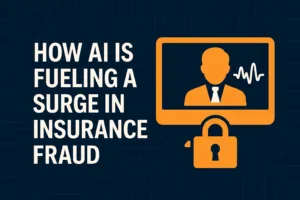AI-powered Insurance Fraud on the Rise
Insurance fraud has always been a serious issue, but new data reveals it’s growing rapidly—and artificial intelligence is making it worse. According to a 2024 report from fraud detection company Pindrop, insurance scams are not only more common than in other industries, but also increasing at an alarming rate.
After analyzing over 1.2 billion customer calls, Pindrop found a 475% increase in synthetic voice fraud at insurance companies. Overall, insurance fraud jumped 19% year-over-year, with a current fraud rate of 0.02%.
This sharp rise is a warning sign. As Pindrop CEO Vijay Balasubramaniyan puts it:
“Voice fraud is scaling at a rate that no one could have predicted.”

Why Insurance Is a Top Target for AI-Powered Scams
While fraud happens across many industries, insurance is 20 times more likely to be targeted than banking. Pindrop highlights four major reasons why:
1. Digital Claims Open More Doors
Digital claim processes are convenient—but they also create easy entry points for scammers.
2. Media-Based Evidence Is Easy to Fake
Insurance claims rely heavily on photos, videos, and voice recordings. These are far easier to manipulate than the secure, structured data used in banking.
3. Payouts Are Larger
Insurance payouts can be significantly higher than typical banking transactions. Each fraudulent claim, therefore, causes greater financial damage.
4. Smarter Scams, Less Phishing
Today’s scammers rely less on phishing and more on social engineering—manipulating systems using insider knowledge or personal information.
Notably, 7% of fraud cases are now classified as “familiar fraud”, where attackers exploit known personal relationships or data.
The Role of AI, Deepfakes, and Synthetic Voices
AI technology is making these scams not just more common—but more believable. According to Pindrop:
-
Deepfake fraud could rise by 162%
-
Scammers are using emotionally realistic synthetic voices
-
AI bots can now complete knowledge-based authentication with stolen info
This isn’t science fiction. Pindrop warns that generative AI fraud could lead to $40 billion in losses in the U.S. by 2027. What started as a few isolated cases in 2023 is now a full-scale wave of AI-powered deception.
Agentic AI: A New Layer of Risk
One of the most concerning trends in the report is the rise of Agentic AI. This refers to AI tools that act on behalf of users—like handling tasks, automating responses, or initiating actions.
As these AI agents become more common in everyday business, it will become harder to distinguish between trusted AI behavior and malicious activity. This could blur the line between genuine customer requests and AI-driven attacks—increasing the risk of advanced cybercrime and undetectable fraud.
How Insurance Companies Can Fight Back
To combat these emerging threats, insurers must evolve their fraud prevention strategies. Pindrop recommends:
✅ Upgrade Authentication Methods
Don’t rely solely on outdated knowledge-based authentication. Use multi-factor verification and biometric voice analysis where possible.
✅ Implement Real-Time Risk Detection
AI-powered fraud moves fast. Your defenses must too. Real-time monitoring can catch threats as they happen.
✅ Train Front-Line Staff Continuously
Customer service reps and contact center agents are often the first line of defense. Make sure they’re regularly trained to spot new types of fraud and social engineering.
Final Thoughts: Stay Ahead of AI-Driven Insurance Fraud
Insurance fraud is no longer about forged documents or staged accidents—it’s now about advanced AI, synthetic voices, and deepfake deception.
As fraud tactics evolve, so must your security measures. By strengthening your defenses now, you can protect both your customers and your business from the rising tide of AI-powered scams.
🙋 Need Help?
Visit the TLD CRM Support Channel or reach out to our team for personalized assistance.